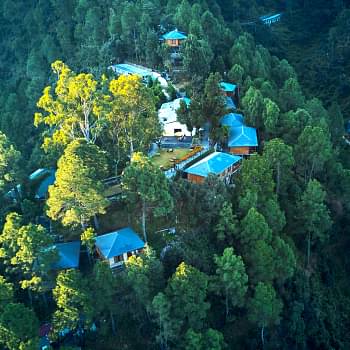April 28, 2021
6 Lesser Known Heritage Sites in India That you Should Visit
CM Content Team


View all
125+
Resorts

View all
2000+
Experiences
'Only At Club Mahindra' Experiences
April 28, 2021
CM Content Team
India has 38 UNESCO World Heritage Sites at present, spread across the country. Of these, 30 are cultural sites, 7 natural sites and 1 mixed site. Visiting these heritage sites in India offers you a glimpse of its rich history and heritage, along with the immense natural beauty that she is blessed with. While you should definitely visit these heritage sites, there are lesser known heritage sites that make for some fascinating sightseeing and exploration. These are heritage sites that you may not have heard about, but which possess an enormous importance in terms of history, culture or aesthetics. In this blog, we bring you 6 lesser known heritage sites in India that you should visit. An offbeat heritage sightseeing tour, that’s what it is.
These are two temples, Devrani Temple and Jethani Temple, collectively called Devrani-Jethani Temples, both of which are dedicated to Lord Shiva. They are located in the village of Tala in Bilaspur district of Chhattisgarh. Both the temples are situated adjacent to each other on the banks of the Maniyari River. According to a popular legend, the temples were built for the wives of two royal brothers.
Most of the Jethani Temple now lies in ruins, with stones lying atop each other. The carvings are still visible to the naked eye at various points. The elephant statues that once guarded the entrance, carved pillars and the ceiling itself, all seem to have borne the brunt of time.
The Devrani Temple stands in a relatively better condition compared to the Jethani Temple. The door frame is still intact, as is the base platform and the stairs which you can use to reach the sanctum sanctorum. Exquisite carvings meet your eyes everywhere, while the thick walls are adorned with lion figures and human faces. There are depictions of courtly scenes or popular folk tales.
The Devrani and Jethani Temples are situated 40 kilometers from Bilaspur on the Raipur-Bilaspur Expressway (NH 30). Outside the site, there is a board in Hindi on which the names of the temples are mentioned.
Sisupalgarh is located in the Khurda district of Odisha close to Bhubaneswar, the capital city. It was once the famous capital city of King Kharavela. Today, the ruins of this historic city are a testimony to its glorious past.
The first excavations at this site were carried out in 1948 by Mr. BB Lal, a famous Indian archaeologist. The excavations led to the findings that this fort city must have flourished between 3rd century BC and 4th century AD.
Today, when you visit this heritage site, you come across stone pillars, remains of a once well developed drainage system, a pillar once worshipped as a Shivling, beautiful elephant carvings, water tank and steps to the gate of what was once the Sisupalgarh Fort. The houses are believed to have been built of stone and bricks, along with a verandah in the front yard. The population of Sisupalgarh is believed to have been about 25,000.
Khurda district, in which Sisupalgarh is situated, is located about 24 kilometers from the capital city of Odisha, Bhuvaneshwar. The nearest railway stations are Khurda Town (5 kilometers), Khurda Road (12 kilometers) and Bhubaneswar (30 kilometers).
The Murud Janjira Fort is situated on a tiny island off the Konkan coast in the Raigad district of Maharashtra. It’s interesting to know that the fort is perhaps the strongest one in the history of India, having repelled attacks by Mughals, Marathas, Portuguese and British, until finally integrating to the Indian Republic in 1947.
The fort walls are about 40 feet high and consist of 19 arches, which have cannons mounted on them. During its heyday, the fort housed around 572 cannons, playing an enormous part in its defence. Seven of these were imported from Sweden, Spain, France and Holland, while the rest were made in India.
Inside the fort, the major attractions are the Rani Mahal, the Palace of the Nawab, a storehouse which once housed the artillery and armoury, rich Persian inscriptions, exquisite carvings and a flagpole. The freshwater pond still has fresh water, and has fishes like trouts and catlas swimming in it.
Today, despite the overgrown vegetation, moss covered ponds and other signs of nature slowly reclaiming the place, you cannot help but be impressed with its architecture, features and the fascinating history associated with it.
To reach Murud-Janjira Fort, you will have to catch a boat ride from the Murud Village. The ride will take you almost 20 minutes, after which you will disembark at the main entrance of the fort.
Eran in Madhya Pradesh does not make it to the list of UNESCO World Heritage Sites, and you wonder why. Every corner of it is steeped in heritage, from the colossal boar statue to the Lord Vishnu temple. Located in Sagar district on the banks of Bina River in Madhya Pradesh, Eran was once the capital of Erakina Pradesha, an administrative division of the Gupta Empire.
The major attractions of Eran are Buddhagupta Pillar, Varaha Temple, Boar statue, temples of Vishnu, Narasimha and Hanuman. Of the most fascinating of these is the gigantic Boar statue, which depicts the Varaha avatar of Lord Vishnu. The statue is almost 11 feet high, 13 feet long and 6 feet wide. It has 1,185 figures of sages arranged in 12 rows all over his massive body. Another major attraction is the Vishnu Temple with a statue of Lord Vishnu which is almost 13 feet high. The temple is the best preserved structure at this heritage site.
Eran is a small village, with Mandi Bamora being the nearest town, about 15 kilometers away. From Mandi Bamora, you can catch an auto rickshaw to reach Eran.
You may have heard of, and even visited, the famous terracotta temples of Bishnupur in West Bengal. But have you heard of the lesser known terracotta temples of Maluti? The Maluti Temples are situated in Dumka district in the village of Maluti in Jharkhand.
The terracotta temples of Maluti are more than 300 years old, dating back between the 17th and 19th centuries. Once, there were 108 temples, but now, only 72 of them remain. The temples were built by the kings of the Raj Basanta dynasty to honour their family deity, Goddess Maulishka.
All the temples are built of terracotta. The temples are dedicated to various gods and goddesses, including the guardian deity, Mauliksha. They are divided into five groups: Sikir Taraf, Rajar Bari, Madhya Barai, Chhoi Taraf and Mauliksha temple complex.
Scenes from the Hindu epics, Ramayana and Mahabharata, adorn various temples. At other temples, scenes from the everyday village life are depicted. One of the temples, called the Maulishka Temple, is still visited by the devotees throughout the year.
The Maluti Temples are located in the village of Maluti in the Dumka district of Jharkhand. The nearest railway station is Dumka Railway Station in Jharkhand. From Dumka, Maluti is located almost 55 kilometers away. You can hire a taxi or any other private vehicle from the railway station to reach Maluti.
Imagine taking a boat ride inside a church when half of it is submerged under water! That’s the kind of experience that awaits you at the Rosary Church in Karnataka, located about 200 kilometers from Bengaluru and 22 kilometers from Hassan in a village called Shettihalli.
The church also has some colourful names attached to it, like The Floating Church and The Submerged Church. Built by French missionaries during the 1860’s, it still impresses one with its Gothic features like pointed arches and ribbed vaults, although most of it is dilapidated. The church and the area around it was abandoned after the construction of the Hemavati Dam and Gorur Dam in 1960.
Come monsoons, and half the church gets submerged under water. During the monsoons, you can explore the interior of the churches with a boat ride which can be taken from the Hemavati Dam. During the summer season, the waters recede and the church can be explored on foot. The surroundings are serene, and as you explore the church, you get this feeling of timelessness.
Buses for Shettihalli are available from Hassan. The driver will drop you at a certain point from where you will have to walk around 10 minutes to reach the church.
Quite a list, isn’t it? How many of these lesser known heritage sites have you visited and what was your experience? Is there anything about them that we have missed out here? Which of these heritage sites are you planning to visit in the future? Let us know, it’s always nice to hear from you!
Mahindra Holidays & Resorts India Limited (MHRIL), India’s leading player in the leisure hospitality industry, offers quality family holidays as also stated by Club Mahindra Resort Reviews, primarily through vacation ownership memberships. While Club Mahindra Membership Fees gives you an opportunity to explore your holidays across the world, the other brands offered by the company are – Club Mahindra Resorts Fundays and Svaastha Spa. As on Mar 31, 2019, MHRIL has 100+ resorts across India and abroad and its subsidiary, Holiday Club Resorts Oy, Finland, a leading vacation ownership company in Europe has 33 resorts across Finland, Sweden and Spain. Visit us at www.clubmahindra.com
Mahindra Holidays & Resorts India Ltd. (MHRIL), a part of Leisure and Hospitality sector of the Mahindra Group, offers quality family holidays primarily through vacation ownership memberships and brings to the industry values such as reliability, trust and customer satisfaction. Started in 1996, the company's flagship brand ‘Club Mahindra’, today has over 250,000 members , who can holiday at 100+ resorts in India and abroad.